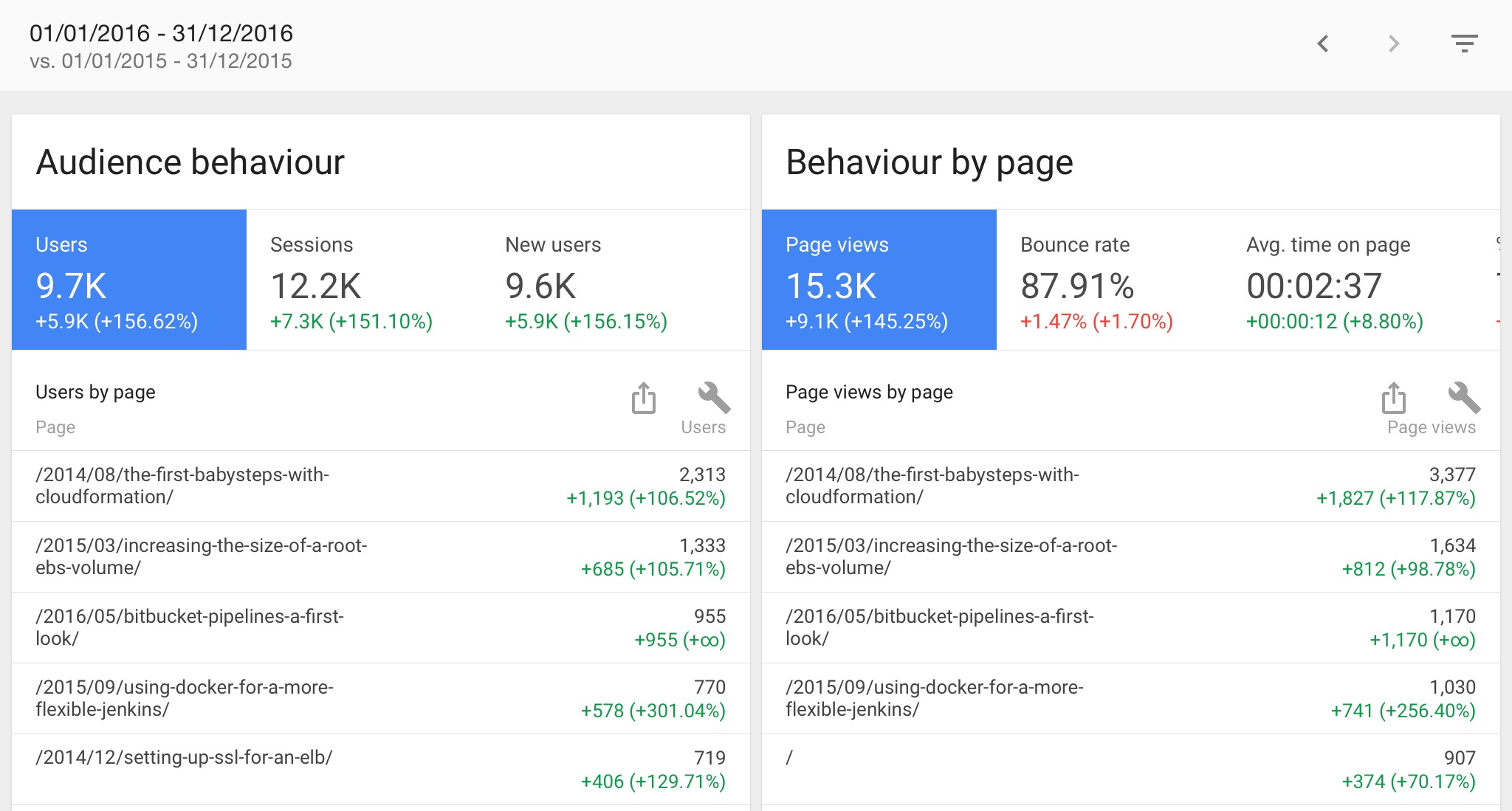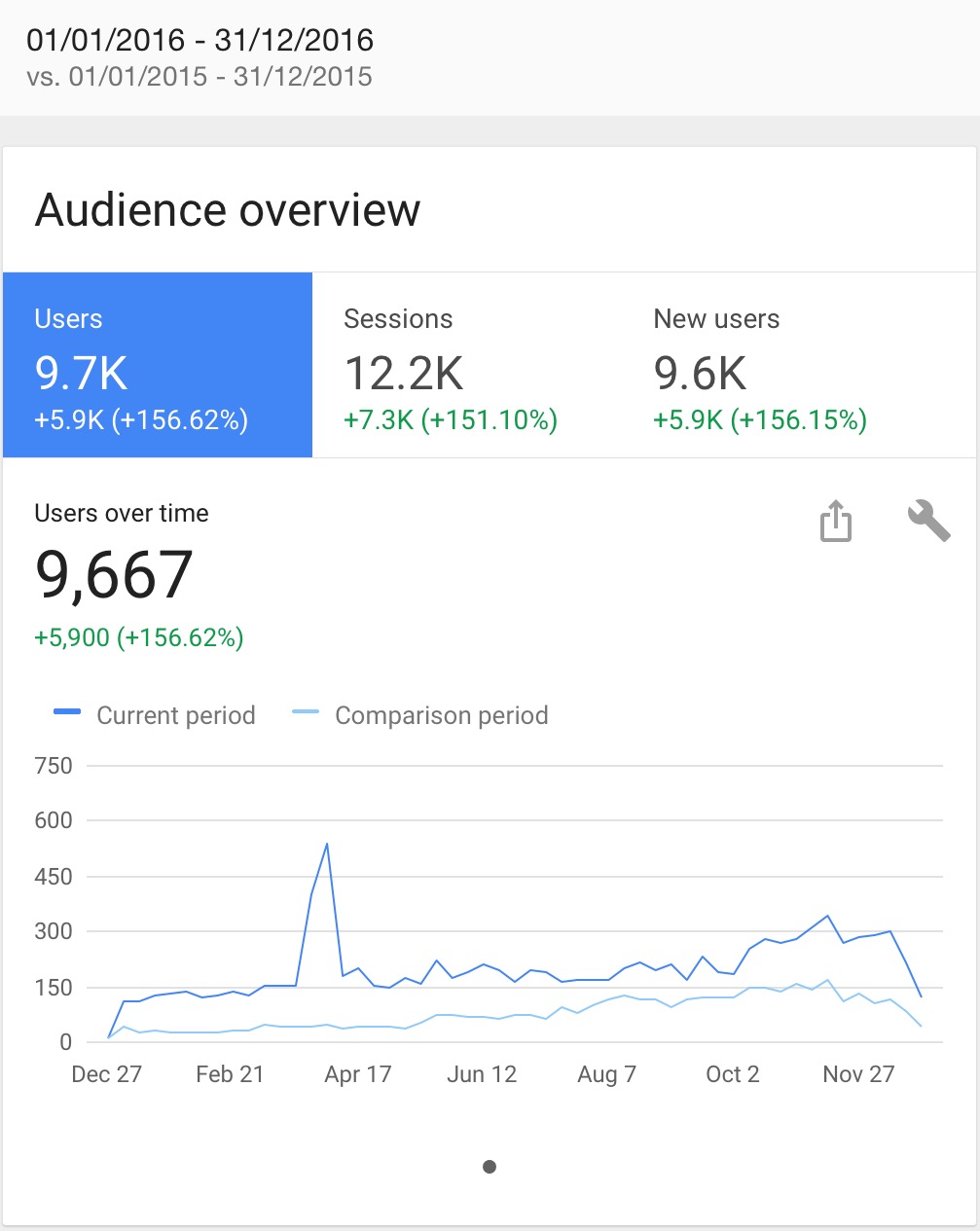Alexa was everywhere at CES, Medium is changing things around, Bitbucket Pipelines introduces some nice features, and I have a look back at how the site did in 2016.
Alexa wins CES
With a new year comes a new CES, and just like last year it seems that the focus is to make everything “smart”. From the possibly useful to the outright ridiculous, manufacturers want you to buy more and more things that go without security updates and become part of botnets1.
As you can guess from the section title though, one tool shows up more than any other. Whereas Google could announce that Android TV will soon come with the Google Assistant built-in it seems like every other new TV will be integrating with Alexa. As will everything else to be honest, including refrigerators. And there will be plenty of alternatives to the Echo as well, as companies release their own speaker systems with Alexa built into it. The Verge has a list of the Alexa products they found if you want to have a look yourself.
Even products that don’t have Alexa built-in directly are creating skills for it, ensuring that it’s now at over 7000 of them. Of course, as we’ve learned with both Apple’s various App Stores and Android’s Marketplace, high numbers don’t reflect quality. However, it does reflect interest and in that way it’s becoming more and more clear that Alexa keeps being the biggest player in the voice-in-a-box field. Now, if the products in that field were to actually be available outside of a couple of “blessed” countries we might be able to see how important it actually is.
Medium’s restructure
Medium is restructuring. The place where every company seems to put their “We’re shutting down” posts2 is changing how they work. The most important part of it seems to be that they will no longer offer ads as a way to make money of your posts, instead limiting their business model to subscription services. The way they phrase it is that ads are bad for content quality and the reading experience3.
Whether this will work out for them in the long run is something that I can’t comment on because I have no insight there. I do know that they’ve had a lot of venture capital investments over the years and I highly doubt they’ve actually been making a profit so far. In that same time I’ve seen plenty of people and company move their blogs to Medium however, so obviously they’re attracting content. Having the content however doesn’t necessarily mean you get to make a profit.
Personally I never really “got” Medium. It’s a good site for reading articles, and a fair number of the links I follow point there but I never started following people there. In fact, the only people I follow on Medium (through RSS) are those that I followed before and who moved to Medium. To me, Medium is the source of those articles instead of the name of the author that is sort of visible somewhere. Maybe I just use it the wrong way though.
And of course, I may be biased but I’m quite happy with having a site that I control and where I can use my own workflow. While being sure that nothing disappears4 if some unprofitable company shuts down.
Bitbucket Pipelines updates
I haven’t spoken about it for a while, but Bitbucket Pipelines has had some interesting updates since my original review. While it still has the limitations I complained about before, it just introduced a feature I’m always annoyed by if it’s not there: a manual trigger.
Manual triggers don’t sound very useful for a CI tool focused on updated code, until you’re configuring your build process and have some setting wrong. I have made far too many updates to README files just to ensure something is triggered. Don’t get me wrong here either, Bitbucket was pretty quick with introducing it. Most of my frustrations were with Wercker not having this (that was a while ago, they have it now).
Probably more interesting after the initial configuration is the ability to have a tag based workflow. If you use a method where releases happen from tags this means you can limit the actual deployment steps to those tags instead of a branch. Of course, this would be even better if you had inheritance between steps so you could just define the extra steps, but I think I already mentioned they haven’t resolved the limitations I mentioned.
A look back
Everyone else does it, and that’s always a good reason to do something right? Anyway, I was mostly curious for myself how the site did last year and if I do te work for that I might as well post it for anyone else to read. Now, to be clear, it’s technically possible5 that you somehow came across this site without realizing that it’s not exactly high-traffic. Luckily, I’m sure that seeing the numbers below will set you straight in that regard.
All of these numbers come from Google Analytics. I have no idea how to track RSS readership right now, and email subscription readership is negligible.

So, readership went up by quite a bit in 2016. From about 4,900 sessions to 12,200 with page views seeing a similar increase to about 15,300. No doubt a result of me actually writing a lot more, although as you can see the only article from 2016 in the top 5 is my First Look at Bitbucket Pipelines while the most popular ones are the older First Babysteps with Cloudformation and Increasing the Size of an EBS Root Volume.
Which is surprising to me, not that the older articles did so well but that it’s this one that was the most popular in 2016. I suspect it’s because it was one of the first pieces written about Bitbucket Pipelines so probably scored high in searches.

However, that leads me to another interesting point of the year. In the image above you can see a very clear spike in traffic in April. At that time I wrote a couple of articles that were picked up by other sources: A Look at Igor’s Internals, Deploying Go Binaries with Wercker, and Multiple Deployments with Wercker. The first one of these showed up on Reddit6 and the second Wercker asked if they could repost the article on their site, where it ended up in their top 10 most popular articles of 2016 list7. Someone at Docker liked the last one and they posted links on their social media and newsletters.
At the time the traffic was amazing to me, but as you can see it was short lived. I have no idea if this actually resulted in some people coming back to the site later or if it was one time traffic. Either way, traffic continued to be consistently stronger over the year and it was fun to see it happen at the time.
As for these weekly notes? They don’t get much traffic at all, in fact you have to dig deep to find them anywhere in the statistics. However, they ensure that I keep updating the site and that makes them important in that regard. Besides, I enjoy writing them just as much as the other articles and I hope you enjoy reading them.
-
Completely unrelated, with Christmas I got a Philips Hue starter set. It’s a lot of fun to play around with, but it means I’m now part of the problem. ↩︎
-
Yes, I’m well aware that there are many other articles on there as well. ↩︎
-
No argument there from me, there’s a reason why ad blockers are so popular. ↩︎
-
When hosting a static site becomes a problem, there are bigger problems. ↩︎
-
But unlikely. ↩︎
-
Obviously not on the front page or even really popular, as otherwise these stats wouldn’t make any sense. ↩︎
-
While they linked to the original article as well, there was barely any traffic from it. ↩︎
